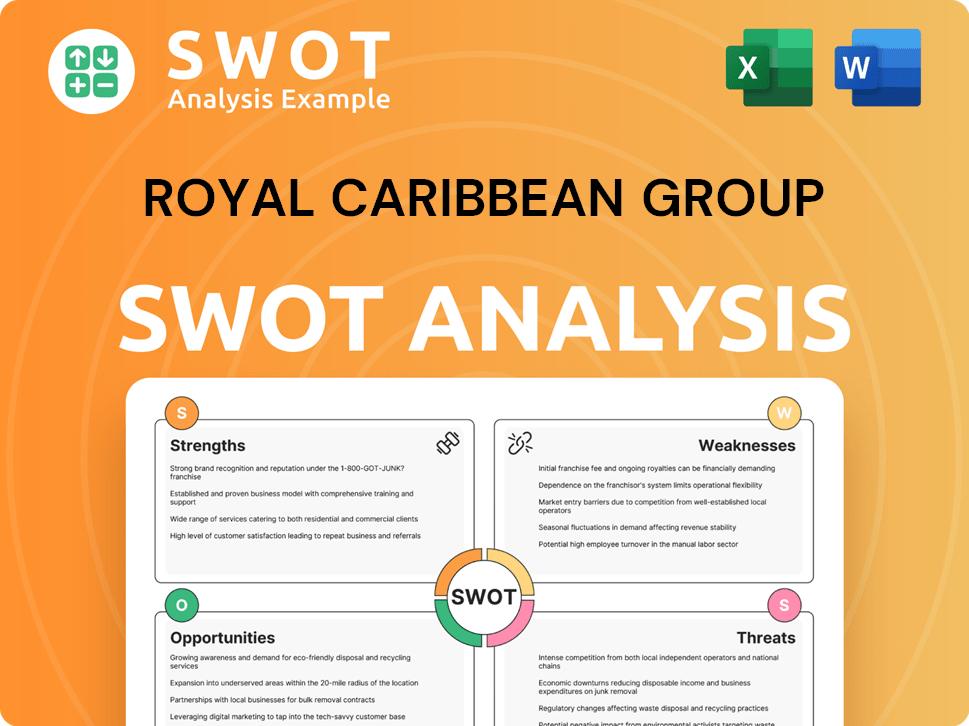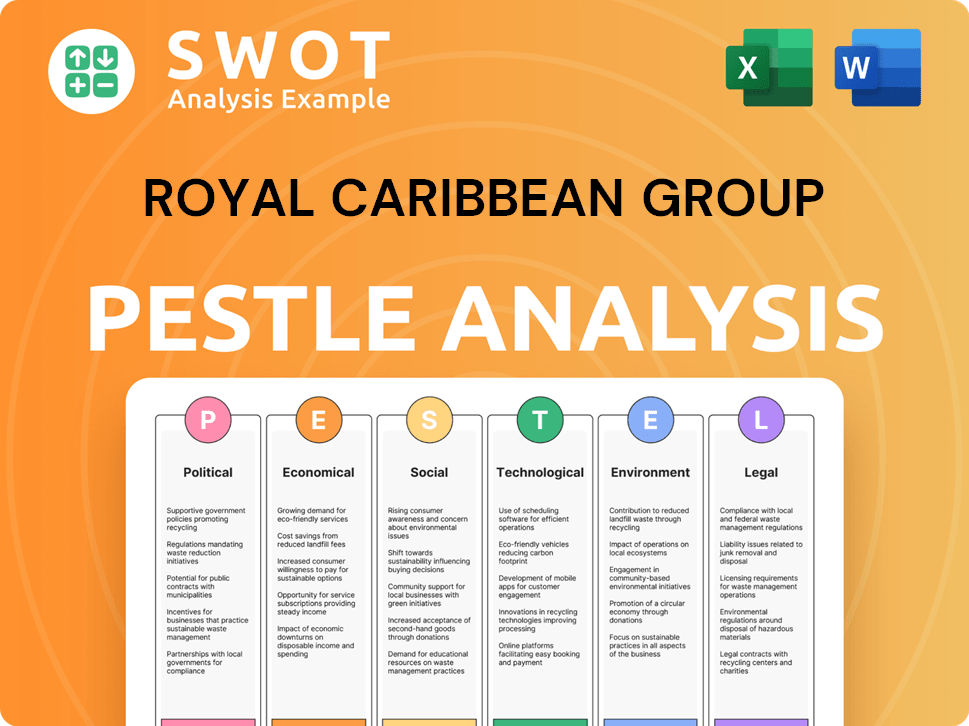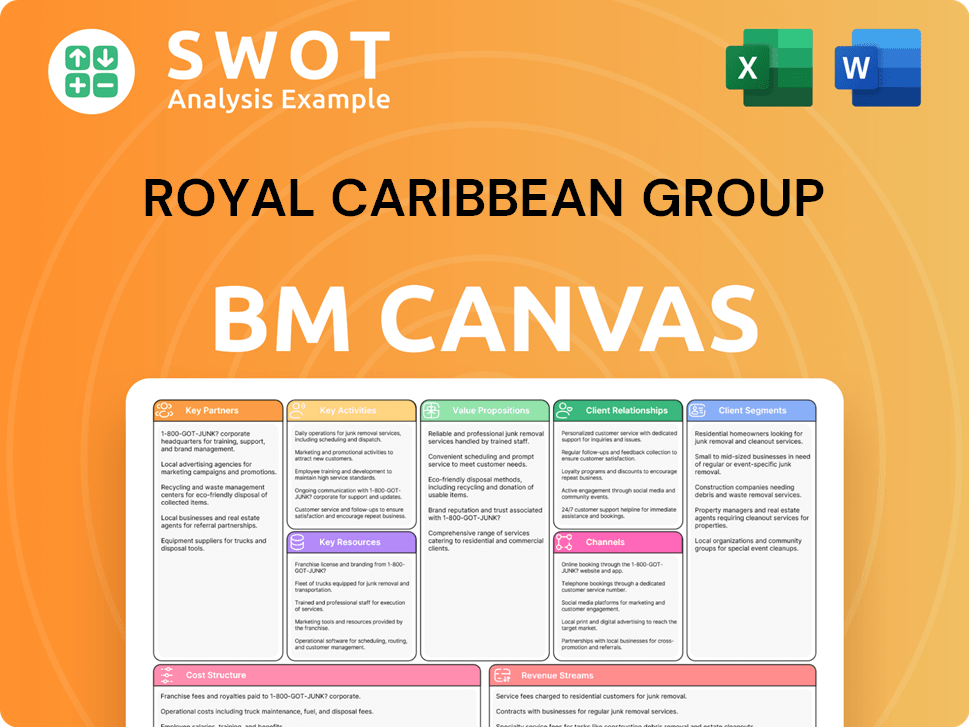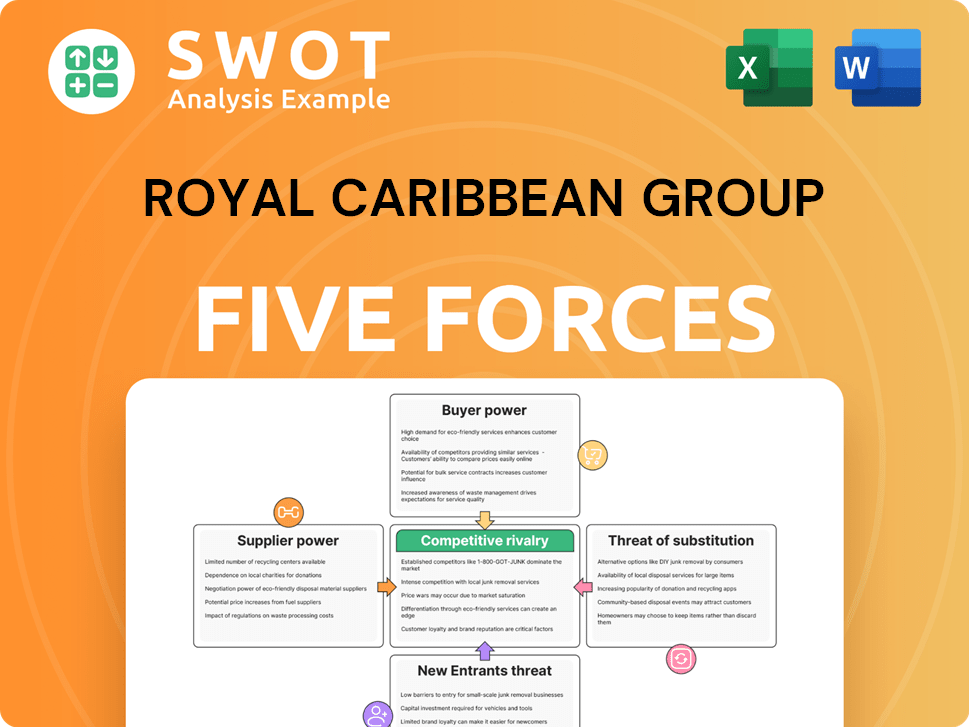Royal Caribbean Group Bundle
Can Royal Caribbean Group Maintain Its Dominance in the Booming Cruise Market?
The cruise industry is setting sail for record heights, with projections exceeding 37 million passengers in 2025. Royal Caribbean Group, a titan in this arena, is navigating a sea of opportunities and challenges. With a history dating back to 1968 and revenues reaching $16.5 billion in 2024, the company's future hinges on its ability to outmaneuver its rivals and cater to evolving consumer demands.

To truly understand Royal Caribbean Group's position, we must delve into its competitive landscape. This analysis will explore its Royal Caribbean Group SWOT Analysis, market share, and strategic advantages, comparing it against key competitors within the cruise industry. By examining its financial performance, growth strategies, and market challenges, we can assess Royal Caribbean Group's ability to thrive in this dynamic environment and its future outlook in the cruise industry.
Where Does Royal Caribbean Group’ Stand in the Current Market?
Royal Caribbean Group holds a strong position in the cruise industry. It ranks as the second-largest cruise line operator globally. This places it in a highly competitive environment alongside major players like Carnival Corporation & plc.
The company's diverse portfolio, including brands like Royal Caribbean International, Celebrity Cruises, and Silversea Cruises, caters to various market segments. This allows it to capture a broad range of customers. The ability to offer different cruise experiences is a key factor in its competitive strategy.
Royal Caribbean Group's market share is substantial. As of Q1 2025, the company held a market share of 27.46% based on total revenue. Royal Caribbean International controlled 27.0% of the worldwide cruise market by passengers and 24.8% by revenue as of 2025. This strong market presence demonstrates its ability to compete effectively.
Royal Caribbean Group's market share is a key indicator of its competitive position. The company's revenue in 2024 reached $16.5 billion. This increase from $13.9 billion in 2023 highlights its growth in the cruise industry.
The company's financial health is robust. Royal Caribbean Group reported a net income of $2.9 billion for 2024. The adjusted net income was $3.2 billion and the adjusted EBITDA reached $6.0 billion. In Q1 2025, net income was $736 million, showing substantial growth.
Royal Caribbean Group operates a global fleet of 65 ships as of March 2024. It also has 5 additional ships on order until 2028. This large fleet allows it to offer a wide variety of cruise options and maintain a significant global presence.
The company's adjusted EPS for 2025 is expected to be in the range of $14.35 to $14.65 per share. This positive outlook reflects the company's successful recovery and growth strategy. Further insights can be found in the Target Market of Royal Caribbean Group.
Royal Caribbean Group's competitive advantages include a diversified brand portfolio, a large and modern fleet, and strong financial performance. These factors contribute to its ability to attract customers and maintain a leading position in the cruise industry. The company's focus on innovation and customer experience further strengthens its market position.
- Strong market share and revenue growth.
- Diverse brand portfolio catering to various segments.
- Global presence with a large fleet.
- Positive financial outlook and profitability.
Royal Caribbean Group SWOT Analysis
- Complete SWOT Breakdown
- Fully Customizable
- Editable in Excel & Word
- Professional Formatting
- Investor-Ready Format

Who Are the Main Competitors Challenging Royal Caribbean Group?
The competitive landscape for Royal Caribbean Group within the cruise industry is multifaceted, involving direct and indirect competitors. The company faces significant challenges from established players and new entrants alike. Understanding the competitive dynamics is crucial for assessing Royal Caribbean Group's market position and future growth prospects.
The cruise industry is highly competitive, with companies constantly vying for market share through innovative offerings, pricing strategies, and enhanced customer experiences. This environment necessitates continuous adaptation and strategic planning to maintain a competitive edge. The introduction of new ships, expansion into new markets, and strategic alliances are key elements of the competitive battles within the cruise sector.
Royal Caribbean Group's Growth Strategy of Royal Caribbean Group must consider these factors to navigate the complex competitive environment effectively. The company's ability to differentiate itself and respond to market changes will be critical for its long-term success.
Royal Caribbean Group's primary competitors include Carnival Corporation & plc and Norwegian Cruise Line Holdings Ltd.
Carnival Corporation is the largest cruise company globally, operating over 100 ships. It competes across various market segments.
Norwegian Cruise Line Holdings Ltd. operates multiple brands, including Norwegian Cruise Line, Oceania Cruises, and Regent Seven Seas Cruises.
MSC Cruises is a privately-owned competitor known for its modern fleet and family-friendly amenities.
New entrants like Aroya Cruises and Eastern Cruise add to the competitive pressure, focusing on specific regional markets.
Royal Caribbean Group also competes with land-based vacation experiences, such as hotels and resorts.
The competitive landscape is shaped by several factors, including the introduction of new ships, mergers, and alliances. These elements directly impact Royal Caribbean Group's market position and require strategic adjustments.
- Market Share: Carnival Corporation holds a significant market share, influencing the competitive environment.
- New Ships: Competitors like MSC Cruises and Disney Cruise Line introduce larger ships, intensifying competition.
- Regional Focus: New entrants, such as Aroya Cruises and Eastern Cruise, target specific regional markets, increasing segmentation.
- Travel Trends: The shift towards unique travel experiences puts cruise lines in competition with land-based resorts.
Royal Caribbean Group PESTLE Analysis
- Covers All 6 PESTLE Categories
- No Research Needed – Save Hours of Work
- Built by Experts, Trusted by Consultants
- Instant Download, Ready to Use
- 100% Editable, Fully Customizable

What Gives Royal Caribbean Group a Competitive Edge Over Its Rivals?
The competitive landscape for Royal Caribbean Group is shaped by several key advantages. The company leverages a strong brand reputation and a loyal customer base, which are crucial in the cruise industry. Furthermore, its innovative ship designs and onboard amenities contribute to a differentiated guest experience, helping it stand out from competitors. A deep dive into the Owners & Shareholders of Royal Caribbean Group reveals the strategic underpinnings of its success.
Royal Caribbean Group's focus on large, family-oriented vessels, such as the Icon and Oasis class ships, is a strategic move to enhance yields and attract a broader customer base. These ships are designed to maximize passenger capacity and onboard revenue. The company's investment in private destinations is another key differentiator, allowing it to control the quality of shore excursions and capture a larger share of passenger spending.
The company's financial performance and strategic initiatives highlight its competitive edge. With a focus on operational efficiency and fleet expansion, Royal Caribbean Group aims to maintain its strong position in the cruise industry. These factors contribute to its ability to compete effectively and drive sustainable growth.
Royal Caribbean Group benefits from a strong brand reputation, which fosters customer loyalty. This loyalty translates into repeat bookings and positive word-of-mouth referrals. The company's ability to consistently deliver high-quality experiences reinforces its brand image and attracts a dedicated customer base.
The company is known for its innovative ship designs and exclusive onboard amenities. These features enhance the overall cruise experience and attract a broad range of customers. The Icon and Oasis class ships, in particular, are designed to maximize passenger capacity and onboard revenue generation.
Royal Caribbean Group's investment in private destinations, such as Perfect Day at CocoCay, is a significant competitive advantage. These exclusive locations enhance the cruise experience and allow the company to control shore excursions. The upcoming Royal Beach Club Experience in late 2025 is another example of this strategy.
The company's commitment to operational efficiency is evident in its improved financial metrics. Royal Caribbean Group aims for a 20% compound annual growth rate in adjusted earnings per share through 2027. The company's ROIC of 15% as of May 2025, demonstrates operational efficiency that may surpass industry peers.
Royal Caribbean Group's competitive advantages are rooted in its brand strength, innovative offerings, and strategic investments. These factors enable the company to attract and retain customers, drive revenue growth, and maintain a strong market position. The company's focus on fleet expansion, with deliveries like Star of the Seas and Celebrity Xcel in 2025, further strengthens its competitive position.
- Strong Brand Reputation and Customer Loyalty: Fosters repeat bookings and positive referrals.
- Innovative Ship Designs and Amenities: Enhances the guest experience and attracts a broad customer base.
- Investment in Private Destinations: Controls shore excursions and increases passenger spending.
- Operational Efficiency: Drives profitability and provides flexibility for growth.
Royal Caribbean Group Business Model Canvas
- Complete 9-Block Business Model Canvas
- Effortlessly Communicate Your Business Strategy
- Investor-Ready BMC Format
- 100% Editable and Customizable
- Clear and Structured Layout

What Industry Trends Are Reshaping Royal Caribbean Group’s Competitive Landscape?
Analyzing the competitive landscape of Royal Caribbean Group requires a deep dive into industry trends, potential challenges, and future opportunities. The cruise industry is experiencing a significant rebound, with an expected 37.7 million passengers projected for 2025. Understanding these dynamics is crucial for evaluating Royal Caribbean Group's market position and future prospects. For more context, you can read a brief history of Royal Caribbean Group.
The company faces both industry-wide and specific challenges, including macroeconomic pressures and evolving consumer preferences. However, strategic initiatives and market expansions offer considerable growth potential. A thorough understanding of these factors is essential for investors and stakeholders.
The cruise industry is currently shaped by a strong post-pandemic recovery. Consumer demand is shifting towards experiential travel, with a focus on transparent pricing. Sustainability and digital transformation are also key drivers within the sector, influencing operational strategies and investment decisions.
Royal Caribbean Group must navigate macroeconomic pressures, including rising fuel costs and inflation. Geopolitical risks and economic downturns can impact demand and operational costs. Staffing shortages across the hospitality sector also pose challenges, requiring innovative workforce strategies to maintain service quality.
The increasing demand for cruise vacations, particularly in the Caribbean, offers continued expansion opportunities. Launching new offerings, like Celebrity River Cruises, and diversifying into new travel segments can capture new market opportunities. Strategic partnerships and investments in new ships and technology also drive revenue growth.
Royal Caribbean Group is focusing on enhancing health and safety measures, a crucial aspect post-pandemic. Strategic investments in new ships and private destinations contribute to revenue growth and profitability. The company is also leveraging technology to improve guest experiences and operational efficiencies.
Royal Caribbean Group's ability to manage costs, adapt to changing consumer preferences, and innovate will be critical. The company's strategic investments in new ships, destinations, and technology are expected to drive further revenue growth. The competitive landscape includes major players like Carnival Corporation.
- Focus on sustainability initiatives to meet environmental standards.
- Enhance customer experience through personalized services and technology.
- Expand into new markets and travel segments to diversify offerings.
- Manage and mitigate geopolitical and economic risks effectively.
Royal Caribbean Group Porter's Five Forces Analysis
- Covers All 5 Competitive Forces in Detail
- Structured for Consultants, Students, and Founders
- 100% Editable in Microsoft Word & Excel
- Instant Digital Download – Use Immediately
- Compatible with Mac & PC – Fully Unlocked

Related Blogs
- What are Mission Vision & Core Values of Royal Caribbean Group Company?
- What is Growth Strategy and Future Prospects of Royal Caribbean Group Company?
- How Does Royal Caribbean Group Company Work?
- What is Sales and Marketing Strategy of Royal Caribbean Group Company?
- What is Brief History of Royal Caribbean Group Company?
- Who Owns Royal Caribbean Group Company?
- What is Customer Demographics and Target Market of Royal Caribbean Group Company?
Disclaimer
All information, articles, and product details provided on this website are for general informational and educational purposes only. We do not claim any ownership over, nor do we intend to infringe upon, any trademarks, copyrights, logos, brand names, or other intellectual property mentioned or depicted on this site. Such intellectual property remains the property of its respective owners, and any references here are made solely for identification or informational purposes, without implying any affiliation, endorsement, or partnership.
We make no representations or warranties, express or implied, regarding the accuracy, completeness, or suitability of any content or products presented. Nothing on this website should be construed as legal, tax, investment, financial, medical, or other professional advice. In addition, no part of this site—including articles or product references—constitutes a solicitation, recommendation, endorsement, advertisement, or offer to buy or sell any securities, franchises, or other financial instruments, particularly in jurisdictions where such activity would be unlawful.
All content is of a general nature and may not address the specific circumstances of any individual or entity. It is not a substitute for professional advice or services. Any actions you take based on the information provided here are strictly at your own risk. You accept full responsibility for any decisions or outcomes arising from your use of this website and agree to release us from any liability in connection with your use of, or reliance upon, the content or products found herein.